-
A bit of a false dichotomy here, though. If someone is talking about using a scale as the basis for improvising over a tune, it’s probably because the notes of most the changes are included in that scale. Meaning that a person could use the same tonality or set of notes over all the chords, but in such a way that the chord changes are evident.
 Originally Posted by ragman1
Originally Posted by ragman1
-
09-12-2023 01:08 PM
-
 Originally Posted by ragman1
Originally Posted by ragman1
There's a fine line between playing changes and chasing changes.
-
I know that. But a trifle boring I'd say. I'd rather use colour notes, wouldn't you?
 Originally Posted by pamosmusic
Originally Posted by pamosmusic
-
Well, I like to think I play them! I don't really know what you mean by 'chasing' them.
 Originally Posted by mr. beaumont
Originally Posted by mr. beaumont
-
Maybe. But those color notes are usually a little nearer than we like to imagine.
 Originally Posted by ragman1
Originally Posted by ragman1
Just saying you could do it. Playing inside doesn’t mean generalizing the changes. Playing outside doesn’t always mean they’re hit.
-
I'm exactly the same whenever the chords last at least one measure, mostly regardless of tempo.
 Originally Posted by ragman1
Originally Posted by ragman1
Until recently there was a Facebook group called "Jam of the Day" IIRC where people would post one or two choruses of their SOLO improvisation based on the changes of a specific tune. It was all about that: implying the changes without them being actually present at all.
-
If lines clearly outline the chords without any backing, you are expressing the changes. If you are aiming to play things that sound ok over the chords you’re chasing the changes.
Do I have to post that Metheny guitar lesson again? ;-)
-
Chasing changes is when a player is so intent on outlining every chord it becomes "paint by number," it sounds passable, but the melodic and often rhythmic contour often suffers.
 Originally Posted by ragman1
Originally Posted by ragman1
Basically, it's letting the harmony control you.
-
Aha different meaning
 Originally Posted by mr. beaumont
Originally Posted by mr. beaumont
yes that’s the opposite extreme of what I said. Also a problem
-
Jam of the Week is actually back, but it's much lower traffic than before.
 Originally Posted by alez
Originally Posted by alez
But there is really something to practicing without backing and recording yourself. Shows you all the problems with your time too!
-
The thing that I look out for is playing each new chord as if you had no idea it was coming, making no connection to what came before or will come after.
In some settings it's unavoidable e.g. big band, you've never seen the chart or heard the tune, it's misfiled in the book and the band has started before you've got it open on your stand, you have had no chance to look ahead, and the changes are wild (usually they aren't, but it sometimes happens) and then it says solo and it means you. Did I mention it's in Db at 220?
But, more often you have time to look it over, or you might know the tune -- and then your solo should sound like you're playing the tune, not one chord at a time.
-
Yeah that’s a nice way of putting it. Kind of a combination of what they both said.
 Originally Posted by rpjazzguitar
Originally Posted by rpjazzguitar
Jumping through changes without consideration for the actual melody you’re building. But also just building a melody using notes because they don’t clash, but without consideration for the changes going on underneath.
Bit of a high-wire act we’re all working at.
-
The truth is chasing changes, in the definition of being hung up on making every change, is actually part of really getting to know the tune. You want to get to where you can do that. But that's not the end goal.
There are environments too, where a little chasing is good. Playing solo for example...you need to nail the changes more closely so the form keeps moving ahead in the listeners mind.
-
I feel a bit like that sometimes. And I totally rely on changes. I really should practice scenarios that are more static and learn a bit how to deal with them.
 Originally Posted by mr. beaumont
Originally Posted by mr. beaumont
Oh, Jam of the Week, of course that's the one! Originally Posted by mr. beaumont
Originally Posted by mr. beaumont
Well, that way you learn the tune well. It's good so long as it doesn't make you ignore the ears in favour of memory alone. I like to listen. Perhaps a bit too much. I tend to get lost trading fours ha ha! No bass and I get lost.
No way I could survive to a chorus in that situation. I aim at being able to see what the tune does by listening to the choruses before my own solo. It's more than challenging enough already. Originally Posted by rpjazzguitar
Originally Posted by rpjazzguitar
-
Thanks for that clear explanation. Not guilty :-)
 Originally Posted by mr. beaumont
Originally Posted by mr. beaumont
-
Hmm suspicious.
 Originally Posted by ragman1
Originally Posted by ragman1
That sounds like just the kind of thing a guilty person would say.
-
Quit with the rules. If you're going to make rules, makes rules how each chord/scale sounds in your head and then use whichever ones you want to get the effect you want.
What's with the discrimination against natural minor? That's literally the most accurate tonic minor scale there is, why would you not use it? The most accurate tonic minor chord is a triad.
However, usually things get jazzed up. Minor 6 and minor major 7 sound tonic-y but are spooky. Don't always want spooky. I like Christian's suggestion of minor add 9.
I agree with Mr B and Christian that minor 7 doesn't sound tonic-y and sounds less minor because it is also an inversion of a major 6 chord. However, I sometimes use it as a tonic minor to tame the minor sound.
They're all useful to me to get different sounds.Last edited by Bobby Timmons; 09-12-2023 at 09:13 PM.
-
Yes, quit the rules; minor not only comes in different sounds;
 Originally Posted by Jimmy Smith
Originally Posted by Jimmy Smith
those sounds sound further different inside a different song.
Play a Bbmadd9 like this on guitar 6 x 6 6 6 8 - the 9 on top Bb Ab Db F C
Play a Bbmadd9 like this on guitar 6 8 10 6 6 x - the 9 inside Bb F C Db F
(some would call this 9 a 2, depending on which octave they consider the chord tone octave and which the extension octave - jazz needs two octaves for scales and chords)
Play a Bbmadd9 like the second one above as the 2 of the pseudo 2-5 in Stella between the lyrics "at eventide" and "That ripples"... that is a very different minor sound in that context.
Last edited by pauln; 11-04-2023 at 07:52 PM.
-
Which rules are we quitting?
-
Not sure, hope it includes some of the ones
 Originally Posted by pamosmusic
Originally Posted by pamosmusic
that confuse those of us who play by ear.
"The revolution will not be televised"
-
Wouldn’t your first chord be a Bbmi9? It includes the b7 so using the add9 terminology is confusing.
 Originally Posted by pauln
Originally Posted by pauln
Your second chord fingering should be 6 8 10 6 6 x I believe.
Sent from my iPad using Tapatalk
-
The dumb ones like natural minor isn't allowed in jazz.
 Originally Posted by pamosmusic
Originally Posted by pamosmusic
-
Cool.
 Originally Posted by Jimmy Smith
Originally Posted by Jimmy Smith
Works for me.
-
For a Cm tonic, I think the Bb in Cm7 makes it a little more ambigous.
A chord I tend to use in that situation is C F Bb Eb. I've seen it called Cm11, Cm7sus, Cm4/7 and C4.
-
I don't know what this thread's about any more. If I see Cm7 at the beginning of a tune I see Cm and play Cm. It's not very difficult. 7 chords are the jazz sound otherwise we may as well be playing folk music.




 Reply With Quote
Reply With Quote



Gibson LeGrand Missing Split Diamond Inlay
Today, 11:40 AM in Guitar, Amps & Gizmos